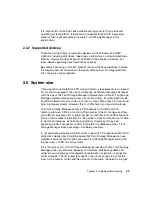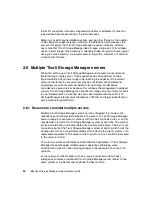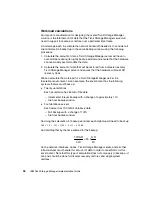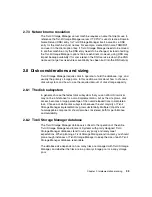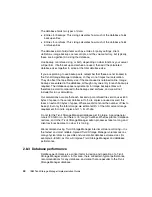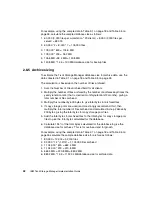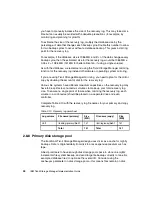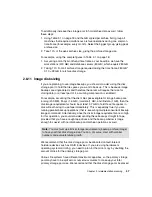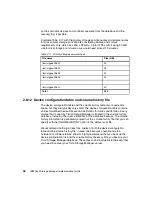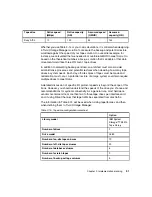
Chapter 2. Implementation planning
45
until space is needed for further backups. This can significantly improve restore
performance for recently backed up files.
As the cost of per megabyte of disk decreases, more and more disk is being
used in Tivoli Storage Manager designs. Some use no tape at all, so that all
backed up data is saved to disk. In this case, the file-type device class should be
used, not a disk-type (even if a disk-type is the initial destination). Disk-type
pools become fragmented if data is retained for extended periods of time, unlike
file-type classes, which can be defragmented.
Tivoli Storage Manager supports a
tapeless
configuration through the use of disk
storage pools or a device class of type file. When deciding whether to use only
disk for backup-archive storage, consider the following caveats:
Do a realistic analysis of the total amount of storage needed considering your
data retention policies, total data, and growth expectations. Evaluate the cost
of tape versus disk for storing all data.
Invest in a disk technology that can permanently store the data. If the device
can fail (and all devices can, whether RAID, mirrored, or anything else),
consider using a copy storage pool for data redundancy.
Carefully consider the cost and technical feasibility of getting the data off-site
for disaster recovery purposes. Tape cartridges are portable. If using disk
only, off-site copies have to be moved over a network transport.
In our scenario, when a client node backs up, archives, or migrates data via
HSM, all data is stored in one primary storage pool. You could also use separate
storage pools for a backup, archive, and HSM data for improved controls and
manageability of production data.
To size the disk storage pool, calculate how much will be backed up during one
cycle and add on a proportion of the amount of archive data transferred to the
server. This amount (plus a contingency for growth) is the recommended size for
the storage pool.
If you are also using Space Management (HSM) features, the rate of data
migration to the server is hard to predict, so you need to get experience of your
particular environment to make an accurate sizing.
Primary storage pools (usually disk devices) can be made larger or smaller than
the recommended size, depending on the resources available. A larger pool size
allows for more than one backup cycle of data to remain on disk, thus improving
restore times. It also allows for spare capacity for an unexpectedly large amount
of backup data to prevent server migration from running during backup. A smaller
primary storage pool uses less disk, but runs the risk that the pool will fill up
during back up. This is not functionally a problem, since the backup and
Summary of Contents for E16RMLL-I - Tivoli Storage Manager
Page 2: ......
Page 23: ...Figures xxi 22 6 AIX lab environment 708...
Page 24: ...xxii IBM Tivoli Storage Manager Implementation Guide...
Page 32: ...2 IBM Tivoli Storage Manager Implementation Guide...
Page 44: ...14 IBM Tivoli Storage Manager Implementation Guide...
Page 94: ...64 IBM Tivoli Storage Manager Implementation Guide...
Page 96: ...66 IBM Tivoli Storage Manager Implementation Guide...
Page 126: ...96 IBM Tivoli Storage Manager Implementation Guide...
Page 298: ...268 IBM Tivoli Storage Manager Implementation Guide...
Page 354: ...324 IBM Tivoli Storage Manager Implementation Guide...
Page 356: ...326 IBM Tivoli Storage Manager Implementation Guide...
Page 423: ...Chapter 12 Scheduling 393 Week of Month Expire Never tsm quit...
Page 424: ...394 IBM Tivoli Storage Manager Implementation Guide...
Page 510: ...480 IBM Tivoli Storage Manager Implementation Guide...
Page 552: ...522 IBM Tivoli Storage Manager Implementation Guide...
Page 554: ...524 IBM Tivoli Storage Manager Implementation Guide...
Page 594: ...564 IBM Tivoli Storage Manager Implementation Guide...
Page 612: ...582 IBM Tivoli Storage Manager Implementation Guide...
Page 618: ...588 IBM Tivoli Storage Manager Implementation Guide...
Page 720: ...690 IBM Tivoli Storage Manager Implementation Guide...
Page 752: ...722 IBM Tivoli Storage Manager Implementation Guide...
Page 758: ...728 IBM Tivoli Storage Manager Implementation Guide...
Page 780: ...750 IBM Tivoli Storage Manager Implementation Guide...
Page 802: ...772 IBM Tivoli Storage Manager Implementation Guide...
Page 823: ...Index 793 Z z OS tape management 58 zOS 200...
Page 824: ...794 IBM Tivoli Storage Manager Implementation Guide...
Page 825: ...IBM Tivoli Storage Manager Implementation Guide...
Page 826: ......
Page 827: ......



